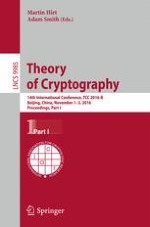2016 | OriginalPaper | Buchkapitel
Composable Security in the Tamper-Proof Hardware Model Under Minimal Complexity
verfasst von : Carmit Hazay, Antigoni Polychroniadou, Muthuramakrishnan Venkitasubramaniam
Erschienen in: Theory of Cryptography
Verlag: Springer Berlin Heidelberg
Aktivieren Sie unsere intelligente Suche, um passende Fachinhalte oder Patente zu finden.
Wählen Sie Textabschnitte aus um mit Künstlicher Intelligenz passenden Patente zu finden. powered by
Markieren Sie Textabschnitte, um KI-gestützt weitere passende Inhalte zu finden. powered by
